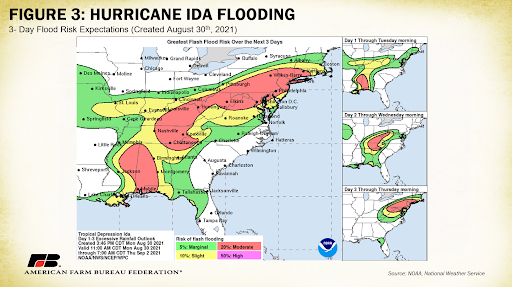Lessons from Hurricane Ida:
The Storm of the Future
In the last week of August 2021, Hurricane Ida brought strong winds and heavy flooding to the Louisiana coast before delivering so much water to the northeast that Philadelphia and New York City saw flooded subway stations days after the storm passed.
And that wasn’t the worst of it. In the days and weeks after the storm, over a million houses lost power and tens of thousands of people lacked access to clean water. Ida also caused a surprising death toll thousands of miles from where the storm first made landfall: the storm claimed the lives of more than 40 people in four states.

All told, according to AP News, Ida is estimated to have caused at least $50 billion in damages.
While Hurricane Ida was an exceptional storm in many ways, it’s important to see this storm as a preview of the potential impact of future hurricanes as the oceans warm. Let’s look at why this is the case and how to prepare to weather the impact of a storm that makes landfall hundreds of miles away.
What Hurricane Ida Can Tell Us About Future Floods
The Geophysical Fluid Dynamic Laboratory at NOAA predicts that over the course of the 21st century, we’ll see increases in tropical cyclone rainfall rates and the intensity of tropical cyclone intensities globally. We’ll also see an increase in the global proportion of tropical cyclones that reach Category 4 and 5 levels due to anthropogenic warming (i.e. climate change) – and Ida is a prime example of how this type of Atlantic hurricane can impact property owners across the eastern United States.
What makes Hurricane Ida a particularly interesting case study for the future is that the storm did not weaken rapidly after landfall, as meteorologists used to expect of tropical cyclones and hurricanes. Instead, as the Royal Meteorological Society reports, Ida maintained Category 4 strength for six hours after landfall, which was possible because of the size of the storm and the temperature of the ocean water it accumulated at sea.
While some were quick to compare Ida to Hurricane Katrina, the most relevant comparable storm only arrived last year: Ida is currently tied for landfall intensity in Louisiana with Hurricane Laura of 2020 and the less recent Last Island Hurricane of 1856. But we can expect to see more similar storms in the years to come.
The Importance of an Accurate Hurricane Forecast
The good news is that meteorologists are getting better at delivering precise forecasts that provide residents in the path of a coming storm with ample notice for safe evacuation. A strong forecast can also alert national emergency responders in advance that their support is likely to be required so that they position themselves to help in short order.
In the case of Hurricane Ida, the storm was predicted to deliver record-breaking rainfalls and flash flooding four days before it made landfall, which allowed millions of residents of southern and central Louisiana to batten the hatches or evacuate to safety.
But resident safety isn’t the only outcome of accurate forecasting: local industries that rely on the Gulf Coast or that maintain operation over the water must also prepare for the arrival of a storm of this magnitude.
For example, even with fair warning, Royal Dutch Shell took a reported earnings hit of up to $500 million as a result of the disruptions caused by Hurricane Ida. These disruptions were caused by issues on the platforms over the Gulf as well as supply chain and consumer demand disruptions resulting from the massive storm.
Why Flood Insurance Is Important for Property Owners Everywhere
While not all disruptions and losses can be covered by affordable insurance, there is one way for property owners to prepare for storms that should not be overlooked: it’s important to have an appropriate flood insurance policy, even if you live far from a coast or any body of water.

When it comes to the impact of Hurricane Ida, inland flooding was more deadly than the initial storm surge. Up in New York and New Jersey, flash flooding trapped residents in basements and caught drivers by surprise on roads located below grade that filled up with water in minutes.
Flash flooding as a result of record rainfalls resulting from Ida were recorded in Tennessee, New Jersey, New York and Connecticut – hundreds of miles from the Louisiana coast. While there’s no way to prevent flash flooding, with the right insurance, property owners are better positioned to recover quickly and weather the financial impact of this type of storm.
Climate Change Is Here: Don’t Be Caught without Flood Insurance
Floods are getting more serious and severe around the world, as hurricane seasons break records for the number of storms and their intensity.
While it can feel daunting to try to prepare for this type of event, there are concrete steps you can take to prepare for a flood:
- Pay attention to flash flood warnings in your area year-round.
- Create and periodically update a family emergency plan.
- Create a 72-hour emergency kit to help you weather the storm.
- Prepare your home to limit the risk of water damage to key appliances.
- Maintain an appropriate flood insurance policy.
And never underestimate the power of a few inches of rain. To learn more about how to insure your property against flooding, contact our team of experts.
Blog Articles
